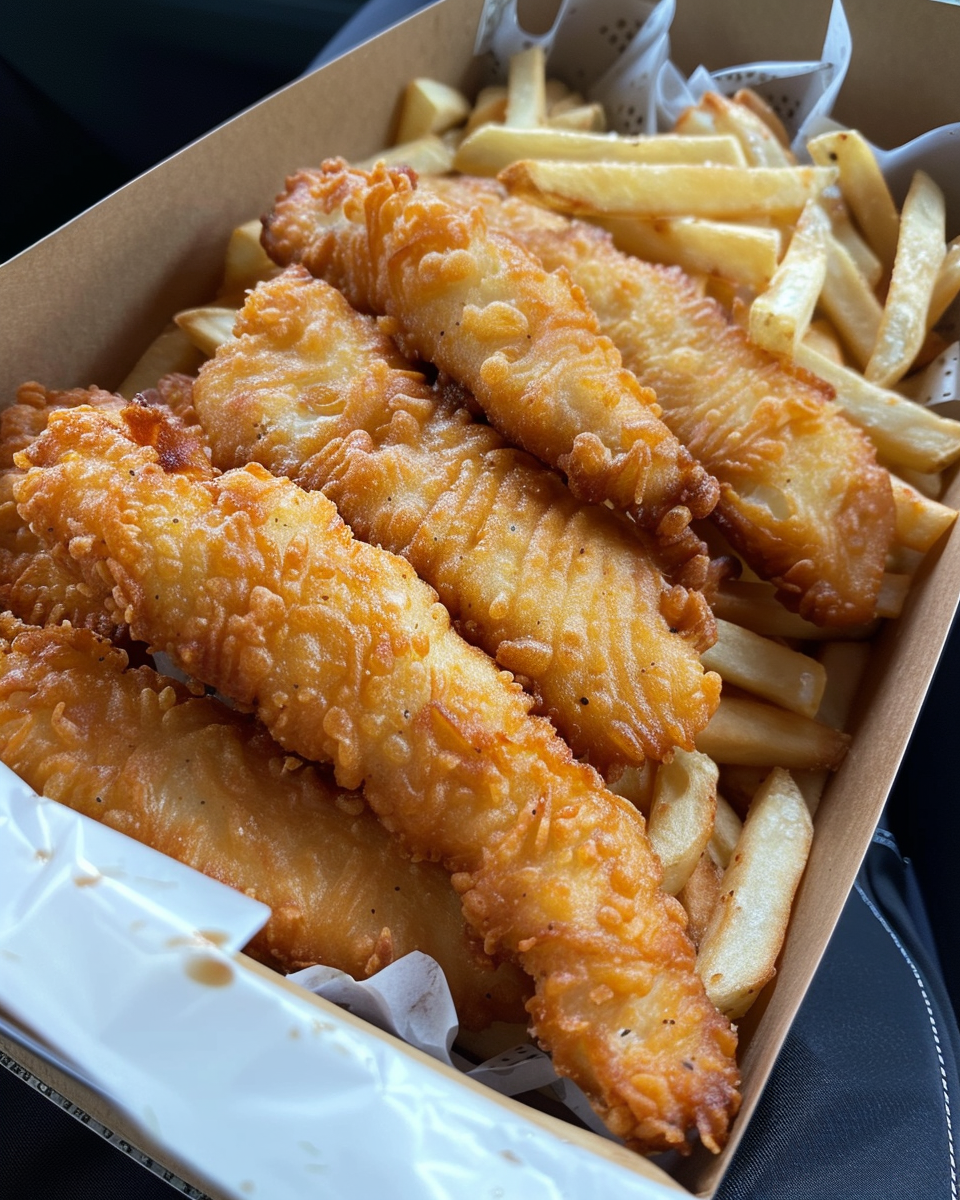Introduction
The appeal of battered fish fingers and homemade chips
Battered fish fingers and homemade chips are a beloved classic, deeply rooted in British cuisine and enjoyed worldwide. This iconic dish is a go-to comfort food that evokes feelings of nostalgia and warmth. Fish and chips are not only famous for their crisp, golden coating and tender fish inside but also for being a simple yet flavorful meal that is perfect for any occasion. Whether you’re enjoying them from a seaside fish shop or making them in your kitchen, this dish never fails to satisfy.
Why make this recipe at home?
While it’s easy to pick up frozen fish fingers and store-bought chips, making this dish from scratch elevates it to a whole new level. Homemade fish fingers allow you to use fresher ingredients, free from preservatives and artificial flavorings. You can also customize the seasoning to suit your preferences, adding extra spices for a kick or adjusting the crispness of the batter. The chips, cut from real potatoes and fried to perfection, far surpass the quality of any store-bought alternative.
What you can expect
This recipe offers a perfectly balanced combination of crispy golden batter encasing soft, flaky fish, and thick, homemade chips that are crunchy on the outside and fluffy on the inside. The contrast of textures and the savory flavors make it an irresistible meal for everyone.
A healthier homemade option
One of the best parts of making your own fish fingers and chips is the control you have over the ingredients. You can opt for fresh fish, high-quality oils for frying, and natural seasonings. By using healthier oils or even baking instead of frying, you can create a lighter version of this traditionally indulgent dish.
Appeal to all ages
Battered fish fingers and homemade chips are a hit with people of all ages. Kids love the fun finger-food aspect of the fish fingers, while adults appreciate the nostalgic comfort and the ability to add more gourmet touches. This dish is versatile, perfect for family dinners, casual get-togethers, or even solo indulgences.
Ingredients
For the Fish Fingers:
- Fresh white fish (cod, haddock, or pollock): Fresh fish is always the best choice, but frozen fish can also work if thawed properly. Cod and haddock are traditional options due to their mild flavor and firm texture, but pollock offers an affordable alternative.
- All-purpose flour: Forms the base of the batter and ensures it adheres to the fish.
- Cornstarch: Added to the batter for extra crispiness.
- Baking powder: Helps create a light, fluffy texture in the batter.
- Cold water or sparkling water: Cold or carbonated water is essential for a light, crispy batter. The carbonation in sparkling water adds air bubbles, making the batter more delicate.
- Egg (optional): Some recipes include an egg for richness and to help bind the batter.
- Seasonings (salt, pepper, paprika): Paprika adds a touch of smokiness, while salt and pepper enhance the overall flavor. Optional additions include garlic powder or cayenne for a spicier kick.
- Oil for frying: Choose a high-smoke-point oil like vegetable, sunflower, or peanut oil for deep frying.
For the Homemade Chips:
- Potatoes: Russet or Maris Piper potatoes are ideal for their high starch content, which results in fluffy insides and crispy outsides.
- Oil for frying: The same oil used for frying the fish can be used for the chips.
- Seasonings (salt, optional herbs and spices): Season the chips with salt immediately after frying, and consider adding paprika, garlic powder, or fresh herbs like rosemary for added flavor.
- Vinegar (optional): A traditional British touch that adds a tangy contrast to the richness of the meal.
Optional Dips and Garnishes:
- Tartar sauce, lemon wedges, ketchup, mayonnaise: These classic accompaniments enhance the flavor and balance the richness of the fish and chips.
- Herbs (parsley, chives, or dill): Fresh herbs can be sprinkled over the dish for a pop of color and flavor.
Instructions (Step-by-Step)
a. Preparation of Fish Fingers
- Prepare the fish: Pat the fish fillets dry with paper towels to remove excess moisture. Cut them into even strips, approximately finger-sized. Season both sides with salt and pepper.
- Make the batter: In a large bowl, whisk together the flour, cornstarch, baking powder, and seasonings. Gradually add the cold water or sparkling water while whisking to avoid lumps. The batter should be smooth and thick enough to coat the fish but not too thick. If using an egg, whisk it in now.
- Heat the oil: Pour the oil into a deep fryer or large heavy-bottomed pan, ensuring it’s deep enough to submerge the fish fingers. Heat the oil to 350°F (180°C).
- Coat and fry the fish: Dip each piece of fish into the batter, allowing any excess to drip off. Fry the fish in small batches to avoid overcrowding the pan, which can lower the oil temperature and result in soggy batter. Cook for 4-5 minutes or until the batter is golden and crisp. Remove with a slotted spoon and drain on paper towels.
b. Preparation of Homemade Chips
- Prepare the potatoes: Peel the potatoes (if desired) and cut them into thick, even chips. Soak the potatoes in cold water for at least 30 minutes to remove excess starch, which helps achieve crispier chips.
- First fry (blanching): Heat the oil to 320°F (160°C). Fry the chips in batches for 3-4 minutes, until they are soft but not yet browned. Remove and drain on paper towels.
- Second fry (crisping): Increase the oil temperature to 375°F (190°C). Fry the blanched chips again for 2-3 minutes until golden and crispy. Drain on paper towels and immediately season with salt.
c. Tips for Perfect Results
- How to ensure the batter sticks: Make sure the fish is dry before coating it in batter. The batter should be thick enough to cling to the fish but not too heavy.
- Frying tips: Keep the oil at the right temperature throughout the frying process. Fry in small batches to avoid lowering the oil temperature, which can result in soggy fish fingers and chips.
- Make-ahead advice: The chips can be blanched and frozen for later use. When ready to serve, simply fry them again to crisp up.
Serving Suggestions
- Classic pairings: Serve the fish fingers and chips with traditional condiments like tartar sauce, ketchup, or malt vinegar.
- Optional sides: Consider serving the dish with coleslaw, mushy peas, or a light side salad to balance the richness.
- Presentation tips: For a fun, nostalgic presentation, serve the fish and chips in a newspaper-style wrap or on a rustic wooden board.
- Health-conscious alternatives: You can bake the fish fingers and chips instead of frying them. Alternatively, use an air fryer for a lighter version that still delivers the crispiness you crave. Sweet potatoes can also be used for a nutritious twist.
Conclusion
Why homemade is better
Making battered fish fingers and homemade chips from scratch is not only more delicious but also healthier and more customizable than store-bought versions. You control the quality of the ingredients and can adapt the recipe to suit your taste and dietary preferences. Plus, the satisfaction of creating such a beloved classic in your kitchen makes the effort worthwhile.
Encouragement to try the recipe
Don’t hesitate to give this recipe a try. Whether you’re cooking for family, friends, or yourself, homemade fish fingers and chips are guaranteed to impress. They offer comfort, flavor, and a sense of nostalgia in every bite.
Final tips
Store any leftovers in an airtight container in the fridge for up to two days. To reheat, use the oven to maintain crispiness rather than microwaving, which can make the fish and chips soggy. Feel free to experiment with different seasonings, fish types, or dipping sauces to make the dish your own.
FAQs
- Can I use frozen fish for this recipe?
Yes, frozen fish works well as long as it is fully thawed and patted dry to remove excess moisture. - How do I prevent the batter from becoming soggy?
Ensure the oil is at the correct temperature (350°F) and fry in small batches. Drying the fish before battering also helps. - Can I bake the fish fingers instead of frying?
Yes, you can bake them at 400°F (200°C) until golden and crispy. Drizzle the fish fingers with a little oil before baking to help achieve a crispy texture. - How do I store leftover fish fingers and chips?
Store them in an airtight container in the refrigerator for up to two days. Reheat in the oven to keep them crispy. - Can I use a different type of fish for the fingers?
Absolutely. While cod and haddock are traditional, other firm, mild-flavored fish like tilapia, catfish, or sole work well too. - What’s the best oil for frying fish fingers and chips?
Oils with high smoke points like vegetable, sunflower, or peanut oil are ideal for frying as they can withstand the high temperatures needed.

